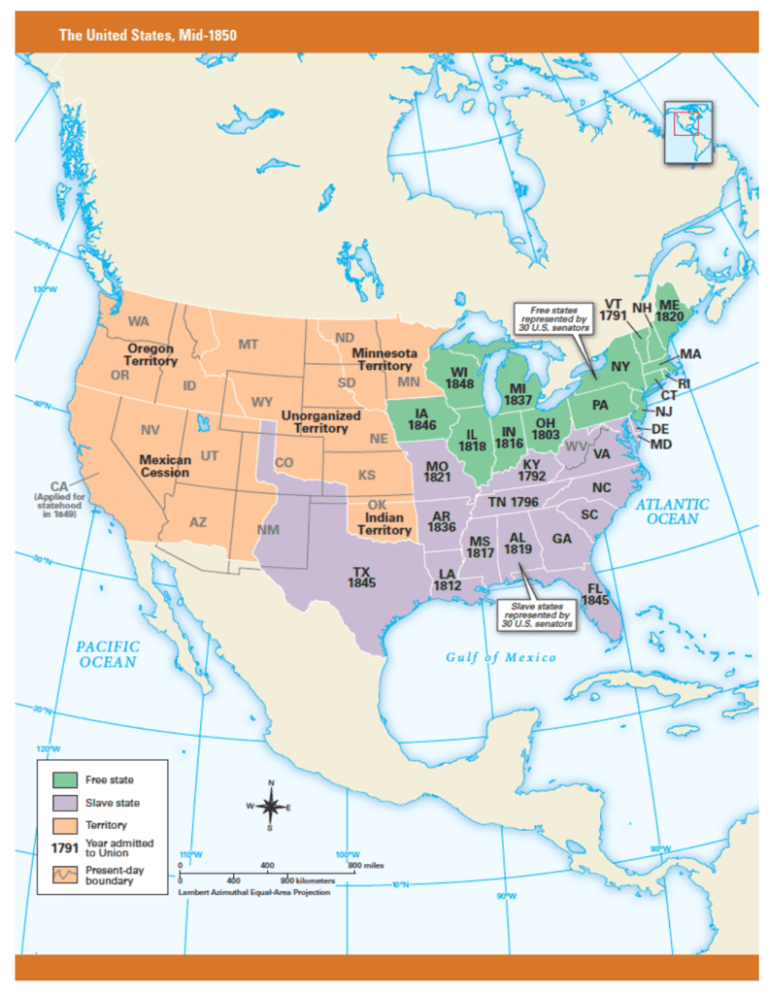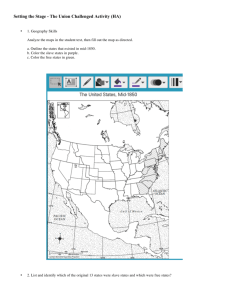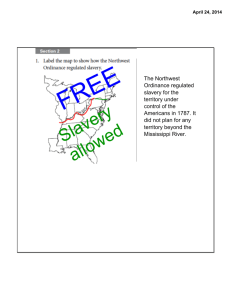The Union Challenged - Mrs. Cortez US History
advertisement

Setting the Stage – The Union Challenged The maps on these two pages show the United States in mid-1850, the year tensions over slavery reached a breaking point. In this unit, you will learn why this crisis developed and how Congress handled it. You will also learn about events after 1850 that further divided the North and South and turned the dispute over slavery into war. As the map on the opposite page shows, some states allowed slavery. Notice, however, that the same number of states banned it. This balance gave the slave states and the free states an equal number of votes in the U.S. Senate. However, as the map on this page shows, that equality did not exist in the House of Representatives, where each state’s votes are based on its population. The Constitution requires that the House and Senate agree on new laws. Southerners believed that as long as the Senate remained balanced, Congress could not pass laws to affect slavery. Then, in 1849, California asked to become a state. California’s new constitution, however, banned slavery. Admitting California as a free state, many Southerners warned, would upset the equal balance between slave states and free states —making the slave states a minority. The 1850s were one of the most troubled decades in U.S. history. Yet, they were mild compared to the 1860s, a time of war, bitterness, and the repair of a broken nation. As you explore the topics in this unit, picture what it must have been like to live during such difficult times. The era’s events drew the American people into a deadly struggle over slavery, freedom, and the very survival of the nation. U n i t 7 G e o g r a p h y C h a l l e n g e Geography Skills Analyze the maps in “Setting the Stage” for Unit 7 in your book. Then answer the following questions and fill out the map as directed. 1. Label the states that existed in mid-1850. How many of them allowed slavery? How many did not? 2. How many of the original 13 states were slave states, and how many were free states? Identify them by placing an S or an F under their names on your map. 3. Find the first 5 states that joined the Union following the original 13 states. Determine whether each was a slave state or a free state. Write an S or an F under the name of each. How many of these new states were slave states? How many were free states? What were the total numbers of slave states and free states as of 1812? 4. In what order did the next 6 states enter the Union? Place an F under the names of the free states and an S under the names of the slave states. 5. What pattern did Congress follow between 1816 and 1821 in admitting new states to the Union? How did this pattern affect the voting power of the North and South in the U.S. Senate? 6. Locate Arkansas and Michigan, and write their admission dates on your map. Did the admission of these states follow the pattern Congress set between 1816 and 1821? Why or why not? 7. Locate the last 4 states admitted to the Union before 1850, and write their admission dates on your map. How many of these states were slave states? How many were free states? © Teachers’ Curriculum Institute USI_ISN_21.indd 199 Unit 7 Geography Challenge 199 5/10/10 5:13 PM U n i t 7 G e o g r a p h y C h a l l e n g e 8. How did the admission of these 4 states affect the voting power of slave states and free states in the U.S. Senate? 9. Which slave state had the most votes in the House of Representatives in mid-1850? How many free states had more votes than this state? 10. Did the free-state North or the slave-state South control the House of Representatives in mid-1850? Critical Thinking Answer the following questions in complete sentences. 11. Why would California’s application to become a state have caused a crisis over the issue of slavery? 12. Why might Southerners be more upset if California were admitted as a free state than Northerners might be if it were admitted as a slave state? 13. California entered the Union as a free state in 1850. In 1854, Congress began preparing Kansas to become a state. Why do you think the question of slavery in Kansas would be a highly controversial issue between the North and South? 14. Minnesota and Oregon were admitted to the Union as free states in 1858 and 1859. Then, in 1860, a man who opposed slavery was elected president. How do you think these events made Southerners feel about the future of slavery in the United States? Explain why. 200 Unit 7 Geography Challenge USI_ISN_21.indd 200 © Teachers’ Curriculum Institute 5/10/10 5:13 PM






